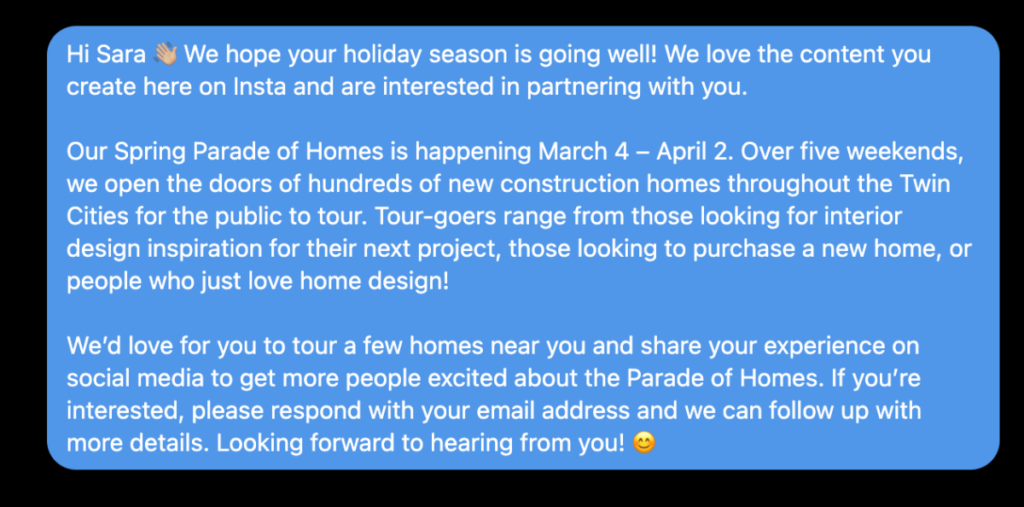Many of us are aware of the power that influencers have for people of all ages. Research shows the average person spends more than two hours a day on social media. Over 60% of millennials and Gen-Z are more likely to trust a brand if an online content creator they trust has reviewed a brand’s product. More astonishing, 40% of young people are turning to TikTok or Instagram as their primary search tool instead of Google. This is why so many companies are looking to partner with content creators that serve their market niche. Partnering with influential individuals is a great way to build brand awareness and get your name in front of relevant audiences that may be unfamiliar with your business.
So, where do you start and how do you successfully work with influencers to market your business?
1. Know your target audience
Step one is understanding what type of people you want to reach. Identify specifics like age, life stage, hobbies, personal life interests, or relationship status. Then, put yourself in their shoes to understand where they spend time online — in Facebook groups, scrolling on TikTok, watching Instagram Stories. This is the foundation for your entire influencer campaign.
2. Establish goals
What tangible outcome is your main focus? Think about where you want to drive consumer attention and how that will be accomplished with an influencer partnership. If your goal is broadcasting to a wide audience, you may want to find influencers with high follower counts and average post reach. If it’s increasing product sales, you may want to look for an influencer in your exact niche with high engagement rates. If it’s breaking into a new market, find content creators with that exact audience.
3. Research your options
Keep your target audience and campaign goals at the forefront of your influencer search. When you’re ready to research, see who your most engaged fans are following or poll your customers to discover popular content creators amongst them. You can also use keywords or hashtags to find local influencers within the app itself.
Consider your budget to determine whether a micro (~less than 5k followers), macro (~more than 20k followers), or middle-ground influencer is a better fit.
4. Find a good fit
It’s important to find a creator that meets your campaign goals, creates content aligned with your brand, and fits your market demographic. For many companies, a local influencer is also important.
See what content they typically post, familiarize yourself with important details about their life, and take note of any brand deals they’ve done in the past.
Before you reach out, make sure you’ve followed this person and engaged with their content. You want them to be familiar with your brand instead of reaching out cold, which can feel transactional and impersonal.
5. Reach out
Identify the best contact method, whether it’s an email listed in their bio or a direct message (DM). In your initial message, introduce yourself, share what you enjoy about their content, and emphasize your interest in a partnership. Instead of overwhelming them with details, provide a brief overview of your campaign goal and confirm they’re interested before sharing more specific details. Here’s an example:

Make sure you’re sending your message from an official account (your company, not your personal). If the conversation started with a DM, always ask for an email to continue communications.
6. Communicate expectations
Once an influencer has expressed interest, share specific details about your campaign and ask for their media kit. Most influencers have one — a document that provides specific data about their audience, engagement rates, previous brand deals, and their rates.
Each influencer may have specific packages they typically produce or craft a unique plan for your campaign goals. Once you’ve reviewed their media kit, communicate your expectations, confirm deliverables, and confirm your payment terms.
7. Secure a contract
Once you’ve agreed upon all outcomes, write up a contract. You can find plenty of examples or templates online to use as a starting point. Make sure to include exact dates, deliverables, prices, payment dates, and signatures. At this stage, it’s also a good time to collect information needed for payment: W-9 forms, mailing address, invoice, etc.
For paid partnerships, it’s important for influencers to disclose advertisements to their followers. Ask them to add the ‘paid partnership’ label on all posts, tag you as a collaborator, and use ‘sponsored by’ or #ad in post copy. Outlining all of these specifics in a contract ensures they’ll be covered in your agreement.
8. Give creative freedom
Be a collaborative partner when it comes to content specifics. Most influencers are creating content and sharing their life online because they genuinely enjoy it. Allow them the freedom to be creative and infuse their personality. Be open to creative photo or video ideas — they know what will resonate well with their audience.
It can be helpful to provide a document of high-level talking points or important details to help guide their voiceovers or captions.
9. Gather insights
Once posting requirements have been fulfilled, track their performance to measure campaign success. We recommend sending out a deliverables form for influencers to fill out at the conclusion of your partnership. Have them provide post analytics like reach, engagement rate, video views, etc. Then, analyze that against your original campaign goals.
It can also be helpful to include an open-answer prompt to ask about any memorable comments or questions they got from followers.
10. Listen & adapt
Use this experience to shape your next partnership. Take influencer feedback and post performance into consideration when shaping your next campaign. The first time you partner with a content creator will likely be clunky and overwhelming. But as you figure out what works and what doesn’t, it will only improve your next venture!

















